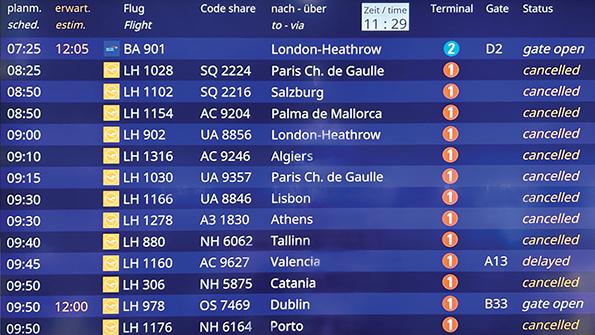
An outage of Lufthansa’s IT system forced a suspension of operations at Frankfurt Airport in February.
For the longest time, airlines, airports, and aviation immigration and security agencies have been promising a new era of “seamless travel” in which airline alliances and technology expedite the traveler through a queue-free, touch-free, hassle-free journey.
Seamless travel, let’s be frank, is an overused, underdelivered industry buzz phrase. There are examples of technology being used smartly to speed air traveler processing and reduce congestion, most notably where it is applied to immigration checkpoints that use eye scans or other biometrics that greatly reduce wait times for most passengers and crews.
But too often, even when the underlying system is working, it falls apart when there’s a crisis or failure, whether it’s an airline or airport system or a failure of an outside grid. Worse, when there’s a weather-related large-scale problem, the added pressure on antiquated airline or airport IT systems can be too much. What should have been a difficult but manageable situation turns into a grinding-to-a-halt nightmare.
People understand their travel plans may need to change if there’s a major snowstorm or other event outside of an airline’s control. But what they fully expect in the third decade of the 21st century is that communication lines remain open, rescheduled itineraries are made quickly and conveyed clearly, checked bags still end up where they should be—with the owner—and overall stress, if not eliminated, is mitigated. Good, modern IT systems can enable that to happen.
Too often in the last few months, that has not been the case. The Southwest Airlines holiday chaos in December was well-documented and delivered a massive knock to its reputation for strong customer service.
In his commentary in this magazine, Southwest COO Andrew Watterson says the airline’s technology never failed during the holiday winter storm event, but the workflow set around it couldn’t “adequately overcome the size of the problem.”
To those customers spending Christmas on an airport floor, that probably felt like a failure. But Southwest’s leadership has now budgeted to spend $1.3 billion on technology projects in 2023, 25% more than it spent in pre-pandemic 2019. It’s a move in the right direction but, judging by a new survey by SITA, it’s not typical of what most airlines and airports are doing.
While more than half of the world’s airports expect to be biometrics-enabled at all passenger touchpoints by 2025, worldwide airline IT spending in 2022 was an estimated $37 billion, $12.6 billion less than in 2019. Perhaps not coincidentally, baggage mishandling rates in the second quarter of 2022 were five times higher than for the same period in 2021.
The unexpectedly rapid return of air travel demand, combined with labor shortages, has undoubtedly exacerbated the air transport industry’s ability to deliver operational reliability, especially when weather, air traffic control or other disruptions are factors.
In February, in two separate events just days apart, operations at Lufthansa and New York JFK Airport were severely affected by outside events. At Lufthansa’s home hub in Frankfurt, fiber-optic cables belonging to a telecom service provider were damaged during construction work, causing an outage of Lufthansa’s IT systems that forced a suspension of all departures and landings at Frankfurt.
At JFK, a small fire knocked out the airport’s power system and brought the gateway hub to a standstill. Passengers and crew on an Air New Zealand flight spent 16 hours in the air only to find themselves right back where they started—in Auckland—because the aircraft was forced to turn back mid-flight after being informed of JFK’s closure.
Bad things happen. In the complicated, highly regulated world of airline operations, those things are often not easily remedied, not least because the remedies must maintain the highest safety standards.
But far too many legacy airlines and long-established international hubs have underinvested in IT year after year. Many of those airlines have undergone large and complex mergers through the years and their technology systems are a patchwork of knitted together systems that perform OK during normal operations but quickly fray under duress.
Expecting airlines and airports to increase IT spending significantly beyond what it was in 2019—when it was likely still not nearly enough—is a hard ask. But passengers, including business travelers, eager to fly again will only see a pattern with each airline/airport chaos headline. At some point, they will start to revert to options they discovered during the pandemic: virtual meetings; drive; don’t go.
Restoring liquidity, reducing debt, returning to profitability, and securing sufficient skilled workers are huge challenges for airlines and airports. IT spending should still be a top priority. It’s an investment that could save their reputations, help them meet those challenges, and put some reality to that promise of seamless travel.





